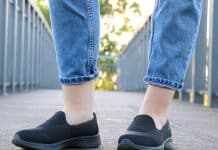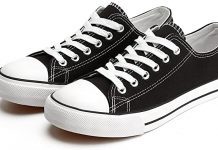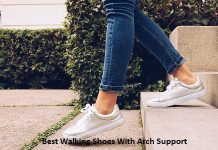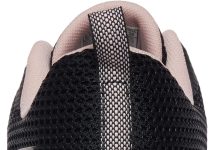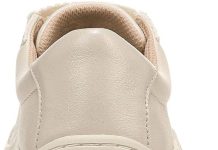Are you someone who enjoys going for walks to stay active? Perhaps you’re wondering if wearing your trusty running shoes for those strolls around the neighborhood is acceptable. Well, you’ve come to the right place.
Today, we’ll explore the question on everyone’s mind: is it okay to wear running shoes for walking?
We’ll tackle this topic head-on and provide you with all the information you need to make the best decision for your walking adventures. So lace up your shoes, and let’s hit the pavement together!
Benefits of Wearing Running Shoes for Walking
Enhanced Cushioning and Shock Absorption
Wearing running shoes while walking provides enhanced cushioning and shock absorption compared to regular walking shoes. Running shoes are designed to absorb the impact of running or jogging, which means they have additional cushioning in the midsole and heel areas. This extra cushioning helps reduce the stress on your joints and muscles while walking, making it a more comfortable experience overall.
Better Stability and Support
Another benefit of wearing running shoes for walking is their better stability and support. Running shoes are built with firmer materials and a broader base than regular walking shoes, which helps prevent your feet from rolling inward or outward when walking. This added stability can significantly reduce the risk of ankle sprains or other injuries while you’re out for a walk.
Improved Breathability and Comfort
Running shoes are often made with breathable materials that allow air to circulate your feet. This helps keep your feet dry and comfortable, especially during longer walks or hot weather. The improved breathability of running shoes can also prevent unpleasant odors and moisture build-up, promoting a more pleasant walking experience.
Promotes Proper Foot Alignment
Wearing running shoes for walking can also promote proper foot alignment. Many running shoes have a slightly elevated heel and a curved sole, which encourages a natural rolling motion of the foot. This rolling motion helps distribute the impact of each step more evenly, reducing strain on your feet, ankles, and knees. By promoting proper foot alignment, running shoes can prevent long-term foot problems and discomfort.
Considerations When Using Running Shoes for Walking
Heavy Weight and Bulkiness
One of the primary considerations when using running shoes for walking is their weight and bulkiness. Running shoes are designed with extra cushioning and support, which can add weight to the shoe. This extra weight may not be ideal for people who prefer lighter shoes or those with certain medical conditions that require less strain on their feet and legs.
Lack of Flexibility
Compared to walking shoes, running shoes are usually less flexible. The stiffer construction of running shoes helps provide stability and support during high-impact activities like running or jogging. However, this stiffness may reduce the natural flexibility of your feet and make walking less comfortable. If you prioritize flexibility in your footwear, running shoes may not be the best choice for walking.
Different Traction and Grip
While running shoes often provide good traction for running on pavement or other surfaces, they may not offer the same level of grip when walking on different terrains. The sole patterns and materials used in running shoes are optimized for forward motion and quick changes in direction. Still, they may not provide the necessary traction for walking on slippery or uneven surfaces. If you frequently walk on challenging terrains or in variable weather conditions, it’s essential to consider whether running shoes will provide sufficient traction.
Inadequate Arch Support
Another consideration when using running shoes for walking is the potential for inadequate arch support. While many running shoes offer some arch support, they may not provide the specific support needed for your foot type. It’s essential to consider your individual arch needs and whether the running shoes you choose can accommodate them. If you have high arches or flat feet, you may require additional arch support inserts or choose walking shoes specifically designed for your foot type.
Importance of Proper Walking Shoes
Reduced Risk of Injury
Wearing the right shoes for walking can significantly reduce the risk of injury. Walking shoes are designed to provide optimal support, stability, and cushioning for the specific walking motion. Choosing the right walking shoes can help prevent common overuse injuries such as shin splints, plantar fasciitis, and stress fractures. Proper walking shoes absorb shock, promote proper foot alignment, and provide adequate support to help you maintain a healthy walking routine without pain or discomfort.
Enhanced Walking Efficiency
Investing in proper walking shoes can also enhance your walking efficiency. Well-designed walking shoes are lightweight, flexible, and responsive, allowing for a natural walking motion. This helps conserve energy and reduces fatigue during longer walks. The right shoes can also improve your walking gait and stride, helping you maintain a steady and efficient pace.
Improved Foot Health
Taking care of your foot health is essential for overall well-being, and wearing proper walking shoes is crucial. Walking shoes are designed to provide sufficient cushioning and support to protect your feet from the impact of walking. They also help distribute your body weight evenly, reducing pressure on specific areas. By choosing shoes that promote foot health, you can prevent issues such as calluses, corns, and bunions and maintain your feet’ overall health and comfort.
Prevention of Musculoskeletal Issues
Wearing the right shoes for walking plays a vital role in preventing musculoskeletal issues. Walking shoes provide stability and support, helping to align your body correctly as you walk. This alignment reduces stress on your joints, ligaments, and muscles, minimizing the risk of knee pain, back pain, and hip discomfort. By prioritizing proper walking shoes, you can enjoy the benefits of walking while protecting your musculoskeletal system.
Signs That Breitling Watch Needs a Service
Uneven Tread Wear
One of the signs that your Breitling watch may need a service is uneven tread wear. Over time, the tread on the bottom of the watch strap can begin to wear down unevenly, indicating that the watch is not sitting correctly on your wrist. Uneven tread wear can affect the fit and comfort of the watch and may also be a sign of internal issues that need to be addressed by a professional watchmaker.
Persistent Aches or Pains
If you’re experiencing persistent aches or pains while wearing your Breitling watch, it may be a sign that it needs a service. The watch should feel comfortable and secure on your wrist without causing any discomfort or irritation. Suppose you notice pain or discomfort even after adjusting the fit of the watch. In that case, it’s best to have it examined by a professional to determine if any repairs or maintenance are required.
Visible Damage or Deterioration
Visible damage or deterioration indicates that your Breitling watch needs a service. This includes scratches, dents, or other damage to the watch’s exterior. Additionally, if you notice any deterioration in the watch’s performance, such as difficulties with the timekeeping or chronograph functions, it’s essential to have it checked by a professional. Timely servicing can prevent further damage and ensure the longevity of your Breitling watch.
Inefficient Shock Absorption
Breitling watches are known for their precise and reliable movements and shock absorption capabilities. If you notice a decrease in the watch’s shock absorption or if it no longer withstands mild impacts, it’s a sign that the watch may need servicing. Efficient shock absorption is crucial for the protection and longevity of the watch’s internal components. By servicing your Breitling watch, you can ensure that it continues to perform at its best and withstand daily wear and tear.
Determining the Right Shoes for Walking
Consider Your Walking Style
When determining the right shoes for walking, it’s essential to consider your walking style. Pay attention to how your feet strike the ground when you walk. If you tend to have more neutral or slightly inward pronation, look for shoes that offer stability and support to help maintain proper foot alignment. On the other hand, if you have a more pronounced inward or outward pronation, you may need shoes that provide additional cushioning and motion control to correct your gait.
Assess Your Foot Arch
Understanding your foot arch is crucial in choosing the right walking shoes. There are three main types of foot arches: high arches, normal arches, and flat feet. High arches require shoes with extra cushioning to help distribute the impact evenly. Normal arches generally work well with most walking shoe styles, but ensuring proper support and comfort is still important. For flat feet, shoes with arch support and motion control are essential to provide stability and prevent overpronation.
Seek Professional Advice
If you’re unsure which shoes are best for your walking needs, seeking professional advice is always a good idea. Visit a specialty running or walking store where knowledgeable staff can assess your feet walking gait and recommend suitable shoes based on your needs. They can provide valuable insights and recommendations tailored to your foot characteristics and walking style.
Proper Sizing and Fit
Regardless of the type of shoes you choose for walking, proper sizing and fit are crucial. Ill-fitting shoes can lead to discomfort, blisters, or even injuries. When trying on walking shoes, leave enough space (about a thumb’s width) between your longest toe and the front of the shoe. Ensure the shoes hug your feet comfortably without being too tight or loose. In-store experts can help measure your feet accurately and recommend the correct size and width for optimal fit.
When Can Running Shoes Be Used for Walking?
Occasional Light Walking
Running shoes can be used for occasional light walking without any issues. Whether you’re strolling around the neighborhood or running errands, running shoes can provide the necessary comfort and support for short periods of walking. However, it’s essential to remember that running shoes may not offer the same flexibility and traction as dedicated walking shoes, so they may not be the ideal choice for long walks or challenging terrains.
Short-Distance Walking
Running shoes are suitable for short-distance walks, such as walking to work or leisurely walking in the park. The cushioning, support, and stability provided by running shoes can make short walks more comfortable and enjoyable. They can absorb the impact of each step and help reduce the strain on your feet and joints. However, if you plan on walking longer distances, choosing shoes specifically designed for walking to ensure maximum comfort and support is best.
Walking on Even Surfaces
Running shoes can be used for walking on sidewalks, pavements, or tracks. They are designed to provide cushioning, stability, and shock absorption, which can enhance your walking experience on smooth and predictable terrains. The grip and traction of running shoes are generally sufficient for walking on these surfaces. However, it’s essential to exercise caution and choose dedicated walking shoes if you encounter uneven or slippery terrains.
Recovery and Rehabilitation
If you’re recovering from an injury or engaging in rehabilitation exercises, running shoes can be used for walking during this period. The cushioning and support of running shoes can help alleviate stress on your joints and muscles while providing a comfortable walking experience. However, it’s crucial to consult your healthcare professional or physical therapist to determine whether running shoes are appropriate for your specific recovery needs.
When Should Running Shoes Be Avoided for Walking?
Intense or Prolonged Walking
Running shoes may not be the best choice for intense or prolonged walking sessions. When walking for extended periods or engaging in high-intensity walking workouts, wearing shoes specifically designed for walking is advisable. Running shoes often have more cushioning and support in the heel, which may not be optimal for the repetitive motion and sustained pressure of long-distance walks. Choosing shoes with appropriate features for walking can help prevent discomfort, fatigue, and potential injuries.
Walking on Uneven Terrain
If you frequently walk on uneven and challenging terrains such as hiking trails or mountainous areas, it’s best to avoid using running shoes for walking. Running shoes typically have a less aggressive tread pattern than hiking or trail-specific shoes, which may compromise traction and stability on uneven surfaces.
Shoes designed for hiking or trail walking offer specialized features like durable outsoles, protective toe caps, and enhanced ankle support, making them a better choice for these terrains.
Specific Foot Conditions
Certain foot conditions may require shoes specifically designed to accommodate them. If you have specific foot issues such as plantar fasciitis, bunions, or Achilles tendonitis, choosing shoes that provide the necessary support and comfort for your condition is essential.
Running shoes may not offer the targeted features needed to alleviate the symptoms or prevent further aggravation of foot conditions. It’s best to consult a healthcare professional or podiatrist to determine the most appropriate footwear for your specific foot condition.
Long-Distance Walking
For long-distance walking, such as marathons or multi-day hiking trips, dedicated walking shoes are recommended over running shoes. Long-distance walking places different demands on your feet and body compared to running. Walking shoes are designed to provide the necessary comfort, support, and stability for prolonged walking. They have additional cushioning, flexible soles, and superior breathability, which can enhance your endurance and prevent fatigue.
Tips for Choosing Running Shoes for Walking
Select Shoes with Ample Cushioning
When choosing running shoes for walking, look for models that offer ample cushioning. The midsole and heel areas should provide adequate shock absorption to cushion the impact of each step. The cushioning should feel comfortable and supportive without being too soft or firm. A good balance is essential to reduce the risk of injuries and ensure a comfortable walking experience.
Look for Adequate Arch Support
Consider the level of arch support provided by the running shoes. Choosing shoes that offer proper arch support is essential if you have high arches or flat feet. This helps maintain proper foot alignment and prevents overpronation or underpronation. The arch support should be comfortable and supportive without causing pain or discomfort.
Ensure Proper Fit and Sizing
Proper fit and sizing are crucial when choosing running shoes for walking. Ensure the shoes fit snugly but comfortably, with enough room for your toes to move freely. The shoes should not feel tight or loose, which can lead to blisters or other foot problems. Try on different sizes and widths to find the best fit for your feet.
Consider Breathability and Comfort
Look for running shoes that prioritize breathability and comfort. Walking can make your feet sweat, so choosing shoes with breathable materials that allow air circulation is essential. This helps keep your feet dry, calm, and comfortable during your walks. Comfortable padding, a well-padded tongue, and a collar can also add to the overall comfort of the shoes.
Tips for Caring and Maintaining Running Shoes
Clean and Dry Your Shoes Regularly
To prolong the lifespan of your running shoes, it’s essential to clean and dry them regularly. Remove any excess dirt or debris from the surface of the shoes using a soft brush or cloth. For stubborn stains, use a mild soap or detergent diluted in water. Avoid machine washing or using harsh chemicals, as they can damage the materials. After cleaning, allow the shoes to air dry naturally before wearing or storing them.
Rotate Shoe Usage
Rotating your running shoes can help extend their lifespan and prevent premature wear and tear. Alternate between two or more pairs of shoes to allow them to fully dry out and recover their cushioning between uses. This rotation also helps alleviate pressure points on specific areas of the shoes, ensuring they stay comfortable and supportive for longer.
Replace Worn-Out Shoes
Knowing when to replace your running shoes is essential for optimal performance and foot health. As a general rule of thumb, running shoes should be replaced every 300 to 500 miles or when you notice visible signs of wear and tear. Look out for compressed cushioning, worn-out treads, or any noticeable decrease in support or stability. When your shoes no longer provide the necessary comfort and protection, it’s time to invest in a new pair.
Store Shoes in a Suitable Environment
Proper storage is essential to keep your running shoes in good condition. Store them in a cool, dry place away from direct sunlight or extreme temperatures. Avoid storing them in damp or humid areas, as this can promote mold or mildew growth. A shoe rack or individual shoe boxes can help maintain the shape of the shoes and protect them from dust or accidental damage.
Conclusion
Choosing the proper footwear for walking, whether dedicated or running shoes, is crucial for a comfortable and enjoyable walking experience. Running shoes offer enhanced cushioning, stability, and support, making them a viable option for light walking, short-distance walking, and certain walking conditions.
However, it’s essential to consider the specific needs of your feet and the walking you engage in. For intense or prolonged walking, uneven terrains, or specific foot conditions, dedicated walking shoes may be a more suitable choice.
Prioritizing foot health, proper fit, and support will help you make an informed decision and ensure a pleasant walking experience. Remember, choose the right shoes for each activity and prioritize your foot health to enjoy the full benefits of walking.


